[ad_1]
Adlink unveiled “Express-ADP” Type 6 and “COM-HPC-cADP” Client “B” modules based on Intel’s recently leaked 12th Gen Alder Lake-H CPUs, featuring 16x PCIe Gen4 and 64GB DDR5. Seco, meanwhile, is prepping a COM-HPC Client “A” module.
After Intel’s announcement of its 12th Gen Alder Lake CPUs, starting with six high-end desktop S-series models, Benchleaks leaked some Geekbench database specs in December that revealed details about the more power-efficient mobile models including Alder Lake-P and higher end Alder Lake-H series chips. Now, in anticipation of a full Alder Lake reveal by Intel in conjunction with this week’s virtual CES show, Adlink has announced two compute modules based on Alder Lake-H. Intel also has a preliminary product page about a Seco module.

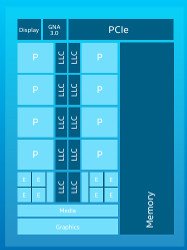
COM-HPC-cADP (left) and Intel 12th Gen Alder Lake architecture
(click images to enlarge)
Adlink’s Express-ADP module uses the COM Express Basic Type 6 form factor and the COM-HPC-cADP complies with the server-class COM-HPC Client Size B. The Adlink modules support applications including ultrasound, test and measurement, industrial edge servers, machine vision, mammography, surgical robots, security or perimeter tracking, and access control.
Seco’s CHPC-D80-CSA uses the smaller COM-HPC Client Size A variant. Like the Adlink products, it supports Linux and Windows (see farther below).
Like the 11th Gen Tiger Lake processors, 12th Gen Alder Lake uses a 10nm fabrication process, in this case, an “Enhanced SuperFin” design called Intel 7. The 12th Gen CPUs debut a hybrid architecture somewhat like Arm’s Big.Little with DynamIQ multi-core orchestration.
Alder Lake uses a combination of “Golden Cove” Performance-cores (P-cores) and lower power “Gracemount” Efficient-cores (E-cores). The hybrid design provides more flexibility for adapting to single- or multithread performance. There is also a new Intel Thread Director technology that dynamically allocates loads in real-time to the appropriate cores, although initially this will be supported only on Windows.
Like Tiger Lake, Alder Lake features high-end, up to 96EU Iris Xe graphics, as well as Intel Deep Learning Boost (DL-Boost) and Intel Advanced Vector Extensions 2 (AVX2) for AI acceleration across CPU and GPU cores. The 12th Gen platform advances to up to 4800 MT/s DDR5 RAM and up to 16-lane PCIe Gen5, which boasts up to twice the throughput over PCIe 4.0. The Adlink modules, however, stick with PCIe Gen4, as it will be a while before PCIe Gen5 cards and modules become available. (For more details on Alder Lake, see our Intel 12th Gen report.)
Only one of the three Alder Lake-H models supported by Adlink is included in the Benchleaks listing of seven models: the 14-core, 20-thread Core i7-12800HE. (Seco does not list individual models.)
The Adlink SKUs are as follows:
- Core i7-12800HE — 14 Alder Lake-H cores (6P+8E/20T); 24MB L3; 45W TDP (35W cTDP); Iris Xe GPU
- Core i5-12600HE — 12 Alder Lake-H cores (4P+8E/16T); 18MB L3; 45W TDP (35W cTDP); Iris Xe GPU
- Core i3-12300HE — 8x Alder Lake-H cores (4P+4E/12T); 12MB L3; 45W TDP (35W cTDP); UHD GPU
Adlink does not list clock rates, but the Benchleaks report lists a 2.8GHz base speed for the Core i7-12800HE with 1,654 single-core and 9,619 multi-core performance scores. As noted in a TechRadar story on the leaks, the performance scores should be taken with some skepticism. The TechRadar charts based on Benchleaks (below) show an unusual hodgepodge of single- and multi-core scores, with some models more optimized for multi-core than others.
By comparison, the initial Alder Lake desktop S-series lineup is led by the 16-core, 24-thread Core i9-12900K with 30MB L3, 2.3GHz/5.2GHz rates on the 8x P-cores and 2.4GHz/3.9GHz on the 8x E-cores. Another point of reference is Intel’s Tiger Lake-H, which is led by an octa-core, 2.4GHz/4.6GHz Core i7-11850HE with 45W TDP and 35W cTDP, which is available on Adlink’s Basic Type 6 Express-TL.
As usual with Intel there is some branding confusion. Adlink’s announcement and block diagrams refer to the chips as Alder Lake-P, but the PR also mentions Alder Lake-H. Elsewhere it says the chips were “formerly Alder Lake-P.”
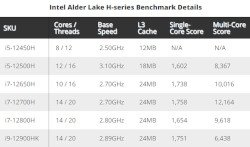
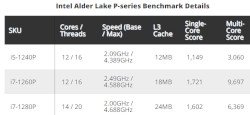
Alder Lake-H (left) and Alder Lake-P processors (scores may be incorrect)
Source: TechRadar based on Benchleaks Geekbench database info
(click images to enlarge)
According to this HardwareTimes story from October, Intel had recently renamed its mobile processors to P-series from U- and H-series. Meanwhile, the TechRadar report linked to above shows separate charts for Alder Lake-H and Alder Lake-P. The P-series chart shows similar core counts than the H-series, but with lower L3 cache and lower base clock rates. It also lists turbo rates, which are not shown for the H-series. Hopefully, Intel will sort it all out for us in a few days.
Adlink Express-ADP
Adlink’s 125 x 95mm Basic Type 6 Express-ADP supports Win 10 and a Yocto based Linux stack, with Ubuntu and VxWorks listed as “TBC.” Supported Intel technologies, dependent on SKU, include Intel VT, Intel HT, Intel SSE4.2, Intel 64 Architecture, Intel Turbo Boost 2.0, Intel AVX512-VNNI, Intel TXT, Execute Disable Bit, Intel Data Protection with Intel Secure Key, and Intel AES-NI. Although Adlink’s three SKUs are listed as 45W TDP (35W cTDP), the datasheet also says the processors support 15W/28W/45W TDPs.
The Express-ADP supports up to 64GB of dual-channel DDR5 at up to 4800MT/s. The module provides Intel I225 series Ethernet controllers for GbE and 2.5GbE, with a potential “TBC” build option for TSN.
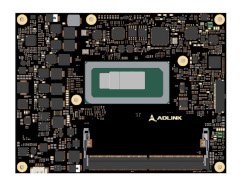
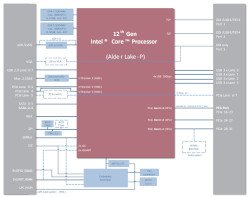
Express-ADP render image and block diagram
(click images to enlarge)
Media features include quad 4Kp60 display support. The Iris Xe SKUs, 8Kp60 for individual displays. There are 3x DDI interfaces for DP 1.4a, HDMI 2.0b, and DVI. You also get single/dual channel 18/24-bit LVDS with up to HD support, or alternately via build option, 4-lane eDP 1.4b. There is also a build option for using one of the DDI links for an HD-ready VGA interface.
Up to two of the DDI interfaces can be converted to USB4 (USB 4.0) with support for DP 1.4a using display alternative mode. There may also be a potential TBC option for converting DDI to Thunderbolt 4, a variant of USB4. The module also supports Realtek ALC886 audio on the optional Express-BASE6 carrier board
Expansion features include PCIe x8 Gen4 (lanes 16-23), PCIe x4 Gen4, (24-27), PCIe x4 Gen4, (28-31), and 5x PCIe x1 Gen3, (0-3, configurable). There are two “build option by project basis” choices: a PCIe Gen3 lane 4 for additional PCIe x1 (5-7) via PCIe switch, and an on-module NVMe SSD that replaces PCIe lanes 28-31. There are also LPC, SMBus, and I2C expansion interfaces, and “GP-SPI” is listed as under TBC status.
Other I/O includes 4x USB 3.2, 4x USB 2.0, 2x SATA III, 2x UART, and 12x GPIO. Super I/O is supported on the carrier, and there is a TPM 2.0 chip. The module ships with Adlink’s SEMA Board Controller with watchdog, etc., as well as a 30-pin debug header.
The Express-ADP offers an 8.5-20V AT or ATX input and ACPI 5.0 power management. Smart battery support is listed as TBC. The module is available in either 0 to 60°C or -40 to 85°C SKUs, and offers 5-90%, non-condensing relative humidity tolerance. Shock and vibration resistance comply with IEC 60068-2-64 and IEC-60068-2-27.
Adlink COM-HPC-cADP
The COM-HPC-cADP adopts the 120 x 120mm Client Size B form factor, which has been seen on modules such as Congatec’s Tiger Lake-H based Conga-HPC/cTLH. OS and Intel technology support is the same as on the Express-ADP, as is the up to 64GB DDR5.
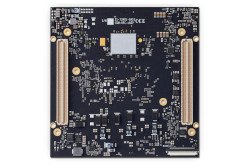
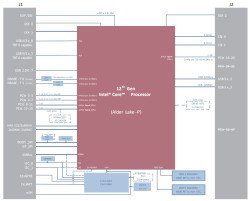
COM-HPC-cADP rear view and block diagram
(click images to enlarge)
Like the Express-ADP, there are 2.5GbE and GbE controllers. There is also support for 2x NBASE-T, which enables 2.5GbE over unshielded (UTP) Cat5e cable and 5GbE over unshielded (UTP) Cat6 cable.
The COM-HPC-cADP supplies 3x DDI, with two of the connections swappable to dual USB4 connections. There is also eDP or a build option swap-out for MIPI-DSI.
Audio support includes 2x Soundwire or 2x DMIC (TBC) plus a choice of HDA, I2S, or a possible TBC option for 2x additional Soundwire. Unlike the Express-ADP, a 2x, 4-lane MIPI-CSI interface is listed as TBC.
The COM-HPC-cADP appears to support 2x standard Thunderbolt4 capable USB4 interfaces in addition to the dual, optional DDI-based USB4 links. You also get 2x USB 3.0, 4x USB 2.0, 2x UART, 12x GPIO, TPM 2.0, and Super I/O on the carrier. A SEMA controller and 40-pin debug interface are also available.
There are more PCIe Gen3 interfaces than on the Express-ADP. You get 16x PCIe Gen4 and 8x PCIe Gen3 plus LPC, SMBus, I2C, and GP-SPI (TBC). Once again, some of the PCIe lanes can be used for an NVMe SSD. Power and ruggedization features are the same.
Seco CHPC-D80-CSA
At publication time, Seco’s site had no mention of the CHPC-D80-CSA module, which is featured on an Intel Partner page. The module deploys Alder Lake-H using a 120 x 95mm COM-HPC Client Size A form factor.
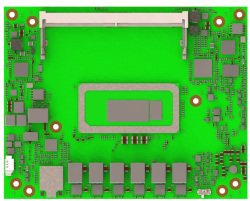
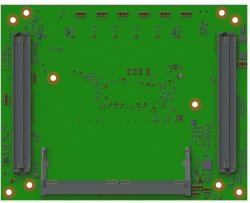
Seco CHPC-D80-CSA render images
(click images to enlarge)
Preliminary specs include up to 64GB RAM, 2x GbE controllers, and support for 8x PCIe x1, 2x PCIe x4, and a single PCIe x8 link. (The PCIe generation was not listed.) The CHPC-D80-CSA will support 4x USB 3.2 Gen1, 4x USB 2.0, and 4x USB Type-C interfaces.
Further information
No pricing or availability information was provided for Adlink’s Alder Lake modules or Seco’s CHPC-D80-CSA. More information may be found in Adlink’s announcement and on its preliminary Express-ADP and COM-HPC-cADP product pages.
More on the Seco module may be found in the Intel page for the CHPC-D80-CSA.
.
[ad_2]
Source link
